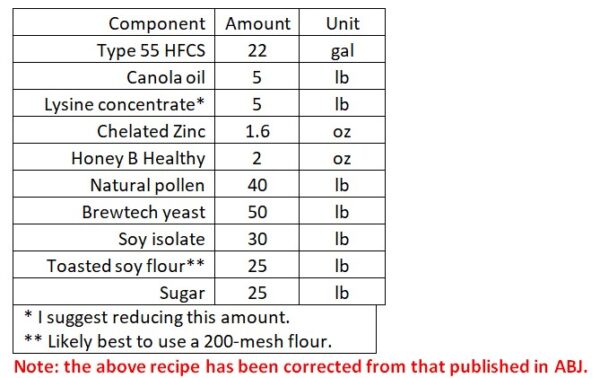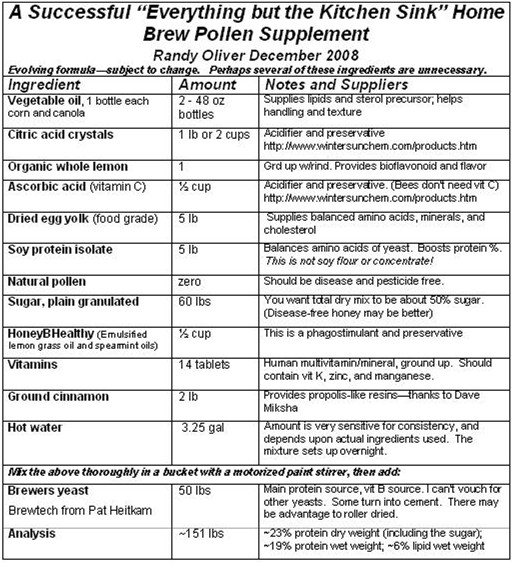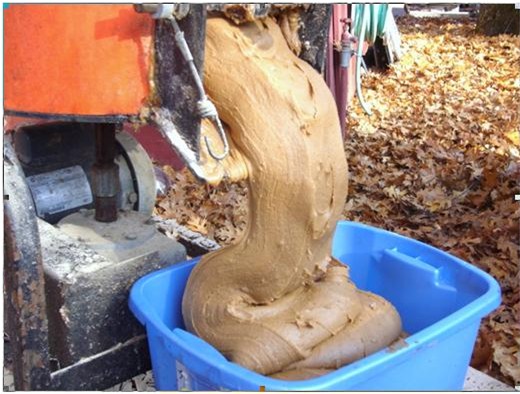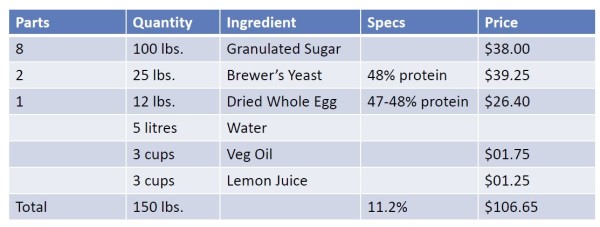Pollen Sub Recipes
Update February 2023: Be sure to check out an updated Homebrew formula from my research in 2020 at https://scientificbeekeeping.com/a-comparative-trial-of-the-pollen-subs-part-5-revisiting-de-groot/
The recipe below was developed by a beekeeper near Bakersfield, CA, and in my trial, outperformed all other tested subs.

Update December 28, 2013
I am currently running a beekeeper-supported controlled trial of the major pollen supplements on the market, with a positive control of natural pollen, and a negative control of no protein feeding. 162 colonies total in the trial, 18 in each test group. I’ve recently completed the first grading for strength. The results were surprising, with two products outperforming natural pollen! As expected, the negative control is doing the worst. Both yeast-based formulations (including a variation of my homebrew formula below) are being poorly consumed. Final results will be in in February.
Interestingly, the Ontario Tech Team found that a yeast/egg homebrew formula similar to my original “homebrew” formula outperformed two off-the-shelf patties. I’ve copied it below. I am not promoting or recommending any formula. When my field trial is complete in February, I will post the results for you to interpret yourselves.
Update April 2012
There are new protein supplements on the market, most of which are very good. I am experimenting with several.
To most, I still add a corn/canola oil blend, food grade dried egg yolk, ground up multivitamin/minerals, some citric acid or lemon juice, and a splash of HBH or ProHealth as a feeding stimulant.
I see that the Kushlan mixer that I use is no longer on the market. Normal concrete mixers will not work–you need a mortar mixer or sausage mixer with rotating paddles. For mixing one sack at a time, it is surprising how quickly you can simply mix it with a garden hoe in a wheelbarrow!
UPDATES NOTE: If you don’t see the changes, hit reload or clear your cashe.
added calc on Hackenberg formula
added Keith Jarret
Updated Feb 25, 2009 added comparison paragraph and table, corrected recipe % dry wt
Update 8/2/09 Jarret analysis
Update 8/25/09 Global patty link
Update 7/3/10 Protein sources
I’ve been asked again and again for the formula that I use. Well, I play with the formula often, and do not swear by any yet. The formula below was a composite of homebrews from various beekeepers, plus my own experimentation. It tested well against others, and I found it to be definitely better than brewers yeast/sugar alone. I will not comment on other proprietary products, since none have enough repeated data to support comparisons.
Testing by the USDA-ARS found that their product, licensed as MegaBee®, performed better than the other products that they tested (www.megabeediet.com/). Commercial beekeepers report success with all the brands offered by the supply houses, Global, Norm Carey, Keith Jarret etc. See also http://www.honeybeeworld.com/misc/pollen/default.htm and http://globalpatties.com/pages/why.htm
Pollen supplement should be fed during pollen dearths. Appropriate times are prior to honey flows, in fall while the last rounds of brood are being raised, if bees are set in almonds prior to actual bloom, and immediately after almond bloom.
The most bang for the feeding buck is in late summer. California beekeepers should start feeding when natural pollen drops off in August, and by September at the latest. Continue as long as bees will take it, generally until about November 1st. Do not let colonies go long between feedings if they are actively rearing brood.
Field trials and practical experience have shown that colonies do well with about a pound a week of supplement, depending on protein content. Successful commercial migratory operations are feeding 10-20 lbs per colony per year, depending upon available natural pollen.
Please let me know of your successes and failures, so that we can figure out better formulas. Please do not post this formula to your web pages. Instead, send the link, or link back to this page, so that I can keep the formula updated.
Update: OK guys, there is a lot of confusion out there in comparing formulas. In general, when comparing livestock feeds, the number one thing that you pay for is protein. So if you want to see if you are getting the most bang for your buck, calculate out how much you are paying per pound of protein.
However, be aware of a few caveats!
1. This assumes that the proteins that you are comparing are equivalent nutritionally. For example, a protein that is either indigestible, or lacking in a single amino acid can’t be compared to a digestible, complete protein.
2. Mann Lake’s use of deGroot’s amino acid ratio is not quite accurate. deGroot did not specify percentages of amino acids–he specified a “normalized” ratio of amino acid weights relative to the amount of tryptophan. deGroot never implied that a formula should be 1.00% trypotophan–rather, divide all other amino acid weights (or percentages) by the weight/percentage of tryptophan, to obtain their relative value. For example, brewers yeast runs about 0.62% tryptophan and 1.7% threonine. So you’d divide 1.7 by 0.62 to obtain a ratio of 2.74:1 threonine:tryptophan, which is close to deGroot’s suggested ratio of 3:1.
The way you use these ratios is to see if any of the amino acids fall below the suggested ratio relative to tryptophan. Any that fall below would be called “limiting amino acids” since they would limit the amount of the total protein that can be utilized by the bees. To overcome that limitation, you would add a second protein source that was high in the limiting amino acid.
3. We are not sure what the optimum protein level is! Kleinschmidt found that the best pollens ran about 25% protein. The other 75% was fat, carbohydrates (some indigestible), minerals, sterols, and fiber. We don’t really know how this works out in a pollen supplement that contains lots of sugar. We will probably find out by trial and error. Mann Lake, Dr. Gordon Wardell, and others selling supplements have done a great deal of research, but have clearly come to different conclusions as to what percent protein is best, or at least, most cost efficient (it’s smart business practice to sell sugar at a dollar a pound).
4. When you are comparing formulas, make sure that you are comparing apples to apples! That is, you can’t compare dry weight to wet weight, or with or without sugar. The only way to really compare them is in the finished, ready-to-feed patty.
There are two ways to determine the actual composition of a patty–by calculation, based upon the guaranteed analysis of the ingredients, or (most accurate) by actual lab analysis. Here are some actual comparisons of ready-to-feed patties. Those that were lab analyzed were guaranteed “fresh” from the distributors, and analyzed by an impartial agricultural lab in California.
Name Type analysis % Protein % Fat pH
MegaBee Lab 17.5 1.1 4.2
Bee-Pro Lab 10.3 5.3 4.8
Global 15% pollen Lab 14.8 2.4 5.5
Keith Jarrett Lab 17.6 7.5 4.9
“Kitchen Sink” Calc’d 19 6 low
Hackenberg Calc’d Can’t compare, since amt water is not spec’d, but dry weight protein is ~15; I’m guessing it would take about 5 gal, which would put protein at 13%
The formula in the table below is experimental, but works well. It is likely that some of the ingredients can be deleted. I added the soy isolate in order to boost the protein level, and to balance the amino acids a bit, but need to test further to see if there is an added benefit. Compare the formula to David Hackenberg’s formula following it.

Update 2022: The best formula that I’ve now tested is shown near the end of A Comparative Trial of the Pollen Subs: Part 5- Revisiting de Groot – Scientific Beekeeping
I mix all ingredients except the sugar and yeast into the water in a bucket with a motorized paint stirrer. I put the dry sugar into the mixer, then pour in the water solution from the bucket, and stir until mixed (put a bucket under the gate to catch any drip). Then I add the yeast on top, and stir until uniform (about 5 minutes). This procedure gives the best mixing in a Kushlan mixer. Water content is critical–too little gives a soupy mix, to much sets up too hard.
We pour the mix into oiled plastic storage tubs, and allow it to set up overnight. It will get firmer, so the poured mix must be soft. I sprinkle sugar over the top of it, so that you can pack it into the tub with your hands without it sticking.
In the field, we dump the tub out onto a sugared board, and cut it up with a spade or floor scraper into 2-3 lb slices, depending upon how much we want to feed. We place the slices between the brood boxes, after smoking the bees off the frames. If you make the formula soft, it will squeeze between the frames.
—————————————————————-
Here is a formula developed, and successfully used, by Dave Hackenberg (by permission):
HACK’S SACK PROTEIN PATTIES
Protein Patty Recipe
1. 125 lbs. Sugar (Add water and keep wet. Should be a little thicker than pancake batter.)
2. Add either 3 cups citric acid or 4 quarts of lemon juice, (this is to put the ph at 4 ½ to 5) 3. Add 1 cup Honey Bee Healthy (optional , but we prefer)
4. Add ½ bag Vitamins & Electrolytes (we use Russell’s) (2 oz. worth)
5. Add 10 lbs. pollen (optional)
(keep the mix wet)
6. Mix in 25 lbs. of Inedible Dried eggs (available from Hackenberg Apiaries)
7. Add 3 ½ cups Canola Oil
8. Mix in 24 lbs. (2 gallons) Honey
9. Finish by adding 50 lbs. Brewtech Brewers Yeast. Water until it has the consistency you desire. (available from Hackenberg Apiaries, Pat Heitkam or David Mendes)
David says that this formula tests out from 16-20% protei; however, by my math it would be about 15% before adding water.
—————————————————————
Note that his formula has much more sugar (plus honey). I tried inedible whole spray dried egg, but didn’t like the consistency, and found that bees didn’t much care for it at high percentage. The brand that I used also smelled like rotten eggs! I found that the dried egg yolks from Honeyville (human food grade) cost a bit more, but are of the highest quality (and smell good).
Sources of mixed supplement:
Keith Jarret ( cnhoney@att.netThis e-mail address is being protected from spam bots, you need JavaScript enabled to view it ) Ingredients not disclosed. Keith says that his product tests at “fat 9% & protein 16%, that is finished product just as the bees would eat. It comes in 200 lb tubs @ $1.05 lb.”
Protein Sources
it is by far easiest in the U.S. to buy off-the-shelf pollen supplements, already tested and proven. There are several excellent ones on the market.
If you choose to mix your own, the most important item in any supplement is the protein source. A great review is in “Fat Bees, Skinny Bees”–a free download https://rirdc.infoservices.com.au/downloads/05-054.pdf Here is a list of some tried and true sources:
1. Natural pollen: the best, but problems with price, parasite spores, nutritional degradation, and pesticides.
2. Brewers Yeast: Brewtech brand works very well. Roller dried yeast may be better than spray dried. Debittered may be more palatable, but I’m not sure. Some brands (such as from corn ethanol production) dry rock hard if not eaten.
3. Torula yeast: good reviews
4. Soy flour: Expeller pressed best, not defatted. This process destroys the anti nutritional factors of soy. Problem with low B vitamins, and some complex sugars.
5. Soy protein isolate: expensive, but might have use as a protein booster and amino acid balancer.
6. Pea protein
7. Corn gluten
8. Barley flour
9. Quinoa flour
10. Dried egg or egg yolk
11. Milk products without lactose. Casein excellent, but too expensive.
Sources for ingredients:
(Broken Link!) http://store.honeyvillegrain.com/powdereddriedwholeeggsandeggwhites.aspx egg yolk, soy
Pat Heitkam, Orland, Calif. 530-865 -9562 Brewtech yeast, commercial orders
tackabery@aol.comThis e-mail address is being protected from spam bots, you need JavaScript enabled to view it commercial orders. soy isolate (tested to be free of melamine), yeast

This photo shows the desired consistency of the fresh mixture. I pour it into oiled tubs to set up. In the field, we dump the tub over onto a board sprinkled with sugar, and slice it up with a floor scraper.
Feedback:
Q: I have a question on the protein receipe. I see you have vitamins added to boost micro nutrients. Can I use kelp meal also? is this an exact receipe or can I add to it?
A: The recipe is a work in progress. It tested very well in a recent controlled trial by myself. I have no idea as to whether additions (or deletions) would help. Might I suggest making a batch in portions, tweaking one ingredient at a time. Then test side by side in colonies. Please let me know your results!




